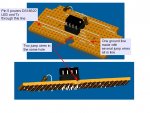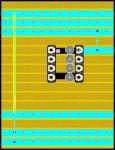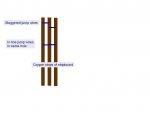Ground plane issues & matching etc aside, I've certainly experienced numerous RF breakthru' hassles over the years, but these have usually been due to Tx powers many orders of magnitude greater (10W-10kW) than our flea power (~10milliWatt) 433 MHz levels. In fact the only 433MHz hassles I've ever had were recent ones, & arose from HopeRF HM-TR units overloading when within ~5m of each other.
Absolutely none of the numerous 433 MHz cheapies I've worked with have given any overload/breakthru' concerns (although some have had other issues!),so IMHO arrange the antenna where wiring best suits. As mentioned before, this whip should be ~175mm for a ¼ wave vertical, & the main reasons I coil it somewhat are to make it both more compact & more visible.
The visibility issue is pretty important for a slender stiff wire at eye level- decades ago I'd ham friend poke an eye badly with a Yagi welding rod element while on a DX Field Day, & the agony the poor guy had to endure has always remained in my mind...
Dippy: Nice thoughts, but many cheapies on offer are often totally unsupported, or have Chinglish manuals awaiting translation/editing.




